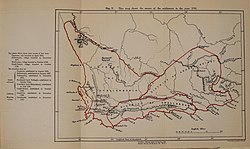
Back Nederlandse Kaapkolonie AF مستعمرة كيب الهولندية Arabic Colonia neerlandesa del Cabo Spanish Alankomaiden Kapmaa Finnish Kaapkoloanje (Nederlânske koloanje) FY מושבת הכף ההולנדית HE Koloni Tanjung Belanda ID Colonia del Capo olandese Italian Nederlandse Kaapkolonie Dutch Dutch Cape Colony SIMPLE
Dutch Cape Colony Kaapkolonie (Dutch) | |||||||||||||
|---|---|---|---|---|---|---|---|---|---|---|---|---|---|
| 1652–1806 | |||||||||||||
 VOC Cape Colony at its largest extent in 1795 | |||||||||||||
| Status | Colony under Company rule (1652–1795) British occupation (1795–1803) Colony of the Batavian Republic (1803–1806) | ||||||||||||
| Capital | Castle of Good Hope (1st) Kaapstad (2nd) | ||||||||||||
| Official languages | Dutch Afrikaans | ||||||||||||
Common languages | Early Afrikaans Khoikhoi isiXhosa Malay | ||||||||||||
| Religion | Dutch Reformed native beliefs | ||||||||||||
| Governor | |||||||||||||
• 1652–1662 | Jan van Riebeeck | ||||||||||||
• 1662–1666 | Zacharias Wagenaer | ||||||||||||
• 1771–1785 | Joachim van Plettenberg | ||||||||||||
• 1803–1806 | Jan Willem Janssens | ||||||||||||
| Historical era | Colonialism | ||||||||||||
| 6 April 1652 | |||||||||||||
• Elevated to Governorate | 1691 | ||||||||||||
| 7 August 1795 | |||||||||||||
| 1 March 1803 | |||||||||||||
| 8 January 1806 | |||||||||||||
| Area | |||||||||||||
• Total | 145,000 km2 (56,000 sq mi) | ||||||||||||
| Population | |||||||||||||
• 1797[1] | 61,947 | ||||||||||||
| Currency | Dutch rijksdaalder | ||||||||||||
| |||||||||||||
| Today part of | South Africa | ||||||||||||
| Historical states in present-day South Africa |
|---|
 |
|
|
The Dutch Cape Colony (Dutch: Kaapkolonie) was a Dutch United East India Company (VOC) colony in Southern Africa, centered on the Cape of Good Hope, from where it derived its name. The original colony and the successive states that the colony was incorporated into occupied much of modern South Africa. Between 1652 and 1691, it was a Commandment, and between 1691 and 1795, a Governorate of the VOC. Jan van Riebeeck established the colony as a re-supply and layover port for vessels of the VOC trading with Asia.[2] The Cape came under VOC rule from 1652 to 1795 and from 1803 to 1806 was ruled by the Batavian Republic.[3] Much to the dismay of the shareholders of the VOC, who focused primarily on making profits from the Asian trade, the colony rapidly expanded into a settler colony in the years after its founding.
As the only permanent settlement of the Dutch United East India Company not serving as a trading post, it proved an ideal retirement place for employees of the company. After several years of service in the company, an employee could lease a piece of land in the colony as a Vryburgher ('free citizen'), on which he had to cultivate crops that he had to sell to the United East India Company for a fixed price. As these farms were labour-intensive, Vryburghers imported slaves from Madagascar, Mozambique and Asia (Dutch East Indies and Dutch Ceylon), which rapidly increased the number of inhabitants.[2] After King Louis XIV of France issued the Edict of Fontainebleau in October 1685 (revoking the Edict of Nantes of 1598), thereby ending protection of the right of Huguenots in France to practise Protestant worship without persecution from the state, the colony attracted many Huguenot settlers, who eventually mixed with the general Vryburgher population.
Due to the authoritarian rule of the company (telling farmers what to grow for what price, controlling immigration, and monopolising trade), some farmers tried to escape the rule of the company by moving further inland. The company, in an effort to control these migrants, established a magistracy at Swellendam in 1745 and another at Graaff Reinet in 1786, and declared the Gamtoos River as the eastern frontier of the colony, only to see the Trekboers cross it soon afterwards. In order to keep out Cape native pastoralists, organised increasingly under the resisting, rising house of Xhosa, the VOC agreed in 1780 to make the Great Fish River the boundary of the colony.
In 1795, after the Battle of Muizenberg in present-day Cape Town, the British occupied the colony. Under the terms of the Peace of Amiens of 1802, Britain ceded the colony back to the Dutch on 1 March 1803, but as the Batavian Republic had since nationalized the United East India Company (1796), the colony came under the direct rule of The Hague. Dutch control did not last long, however, as the outbreak of the Napoleonic Wars (18 May 1803) invalidated the Peace of Amiens. In January 1806, the British occupied the colony for a second time after the Battle of Blaauwberg at present-day Bloubergstrand. The Anglo-Dutch Treaty of 1814 confirmed the transfer of sovereignty to Great Britain.
- ^ Cite error: The named reference
Martin1836was invoked but never defined (see the help page). - ^ a b "Kaap de Goede Hoop". De VOC site. Archived from the original on 6 May 2019. Retrieved 8 February 2013.
- ^ J. A. Heese, Die Herkoms van die Afrikaner 1657–1867. A. A. Balkema, Kaapstad, 1971. CD Colin Pretorius 2013. ISBN 978-1-920429-13-3. Bladsy 15.

